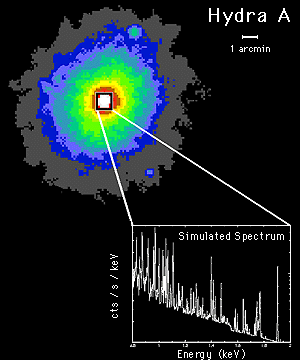What's So Special About X-ray and Gamma-ray Spectra?

Simulated X-ray spectrum of what
could be observed from radio galaxy
Hydra A by the future Constellation-X
mission. |
One reason X-ray spectra are special is that, sometimes, X-ray spectroscopy is simpler to interpret
than optical spectroscopy. This is because, at X-ray temperatures, atoms
are highly ionized (most of the electrons have been taken away from the
atoms), leaving only a few electrons per nucleus. This makes theoretical
calculations much easier! Thus it is, in principle, much easier to relate
the strengths of X-ray lines to, for example, the abundances of
various elements.
A more important reason is that there are many classes of astronomical
objects that contain high temperature gases (at millions of degrees K).
At these temperatures, more of their energies are radiated as X-rays
(both continuum and lines) than at other wavelength ranges, so it makes
sense to observe them in the X-rays. Such hot gases can be found, for
example, in the corona of the Sun: the observation of the Solar corona
is very important because Solar flares and other activities there
can affect satellite communication links and the health of astronauts
in orbit. Many of the elements that you and I are made of are produced
by, or dispersed by, supernova explosions --- and supernova remnants are
prominent in the X-ray sky because they are also at X-ray temperatures.
Another example is the clusters of galaxies: studies show that the X-ray
emitting (and otherwise hard to detect) gas may add up to for far more
(in terms of their total mass) than the stars that we can see in the form
of these galaxies.
Lines in the optical to X-ray range are produced by atomic (and molecular)
processes. In the gamma-ray, though, the lines are produced by different
processes. Gamma-ray lines may be produced by nuclear processes --- each
species of atomic nuclei has its own own set of characteristic lines,
just like atoms do. Nuclear reactions (fission or fusion) leave the nuclei
in an unstable state, which then emit gamma-ray lines. In normal stars, all
the nuclear fusion takes place at their cores, so the Gamma-rays cannot escape
unhindered. However, supernova explosions leave some of these unstable nuclei
in the open, and gamma-ray lines from supernova remnants have been
detected.
In some X-ray binaries and active galactic nuclei, positrons (anti-particle
of the more familiar electron) are produced. A positron and an electron
can annihilate each other, creating two gamma-ray photons of 511 keV
each.
The technology to observe these gamma-ray lines is not as well developed
as at other wavelengths. Still, there have been many important discoveries
in the last decade or so, using the Compton Gamma Ray Observatory, among
others. The technology is developing rapidly, and we hope to learn a lot
about the most violent processes in the Universe using these gamma-ray line
in the near future.
|
